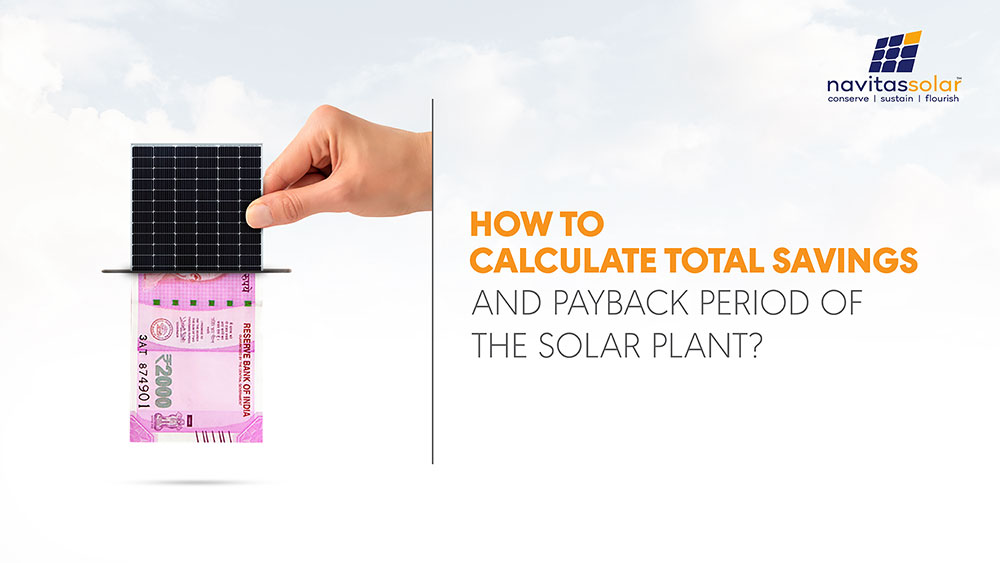How To Calculate Total Savings and Payback Period Of The Solar Plant?
What if we tell you that you can save up to ₹30,000 every year and at the same time, switch to a sustainable lifestyle?
No matter how dreamy it sounds, it is possible with a Solar Plant. Installing a Solar Plant can attract big savings in your cost every year. To explain it further with the help of some figures, we will take an example with the following equation.
Total Monthly Savings from 1kW Solar Plant = Total kWh Generated by the Plant in a Month x Electricity Tariff Rate (₹/kWh).
From our previous blog, We learned that 1kW Solar Plant can generate power up to 120 kWh (Units)
And, let us assume the Tariff Rate of Electricity Consumption is ₹7 Per kWh (Unit).
Accordingly,
| Total savings from a 1kW Solar Plant | |||
| Time Period | Total kWh Generated by the Plant (a) | Electricity Tariff Rate (b) | Total Savings in ₹ (c) = (a x b) |
| Monthly | 120 kWh | ₹7 | ₹840 |
| Yearly | 1440 kWh (120 x 12) | ₹7 | ₹10,080 |
Generally, for a Regular Household in India, a Solar Plant of 3kW is required.*
| Total savings from a 3kW Solar Plant | |||
| Time Period | Total kWh Generated by the Plant (a) | Electricity Tariff Rate (b) | Total Savings in ₹ (c) = (a x b) |
| Monthly | 360 kWh | ₹7 | ₹2520 |
| Yearly | 4320 kWh (360 x 12) | ₹7 | ₹30,240 |
Now, Let’s calculate the Total Saving & Payback Period of Solar Plant
Due to the above-mentioned savings in cost, the Investment In a Solar Project can recover your Initial Investment in No Time. Solar System is one of the very few Risk-Free and Profitable Investments you can get your hands on. Unbelievably, the Payback Period of a Solar Plant is not more than 2-3 Years.
You must be wondering what the Payback Period actually is? Well, allow us to Explain in Detail.
In layman’s terms, The payback period is nothing but The Period it Takes to recover the Initial cost of an Investment, or in other words, how much time does an investment take to hit its Breakeven Point.
To calculate the Payback Period of a Solar Plant, we will need certain factors. For example, the Size of the Solar Plant required for your Home, the Total Initial Cost of installing such Plant, Total Amount (in ₹) saved from the Plant. The size of the Solar Plant System is one of the most crucial aspects for calculating the Payback Period. The Larger the System, the Lesser the Payback Period is.
Let’s take the example we discussed above to calculate its Payback Period.
Accordingly, the average electricity consumption per month for a 3kW Solar Plant is 360 Units or kWh. Whereas installing a 3kW Solar Plant would require approximately 300 Sq. Ft. Shadow-Free Space.
Hence, Total Yearly Savings from a 3kW Solar Plant would be ₹30,240.
A 3kW Solar System generally costs around ₹1,22,979 without Subsidy. However, for a Residential Rooftop, a 40% Subsidy is provided by the Government. Therefore, with the Subsidy, the same system will cost around ₹73,787.
Payback Period= Initial Investment/Cash Flow or Savings Per Year
| Total savings from a 3kW Solar Plant | |||
| Type of Plants | Total Initial Investment (a) | Cash Flow or Savings Per Year (b) | Payback Period (c) = (a x b) |
| Solar Plant Without Subsidy | ₹1,22,979 | ₹30,240 | 4 Years |
| Solar Plant With Subsidy | ₹73,787 | ₹30,240 | 2.4 Years |
Various Other Factors such as Increasing Grid Electricity Tariff Rates, Availability of Financial Incentives, Net Metering, and Ease of Installation with EPC also affect the calculation of the Payback Period. However, Generally, the Payback Period for the Solar System is 2-3 Years.
Now that you have understood how much savings can a Solar Plant bring, you can easily proceed with a Solar Project Installation without worrying about the investment. Get in touch with Navitas Solar to get these systems installed. Visit www.navitassolar.com for more information.


 Online | Privacy policy
Online | Privacy policy
Related Posts
You May Also Like
Bonito Series: Driving Innovation in…
Read MoreTOPCon Series: The Next Generation…
Read MoreValuable Points to Remember During…
Read MoreNavitas Planet Partners with Hysolwin…
Read MoreDriving Towards a Sustainable Future:…
Read MoreWhy Do Top-Grade EVA Sheets…
Read MoreBonito Series: Driving Innovation in…
Read MoreTOPCon Series: The Next Generation…
Read MoreValuable Points to Remember During…
Read MoreNavitas Planet Partners with Hysolwin…
Read MoreDriving Towards a Sustainable Future:…
Read MoreWhy Do Top-Grade EVA Sheets…
Read MoreBonito Series: Driving Innovation in…
Read MoreTOPCon Series: The Next Generation…
Read MoreValuable Points to Remember During…
Read MoreNavitas Planet Partners with Hysolwin…
Read More